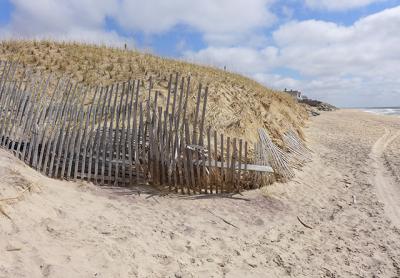Trustees Win Round in Beach Battle

The East Hampton Town Trustees scored a victory in State Supreme Court this month when a judge denied a request for summary judgment by an East Hampton Village resident who constructed a 166-foot-long rock revetment on the ocean beach in front of her house after her property was damaged during Hurricanes Irene in 2011 and Sandy the following year.
The trustees assert that they, on behalf of the town’s residents, own a substantial portion of the West End Road property on which Mollie Zweig constructed the revetment. Ms. Zweig argues that the deed to her property includes ownership to the mean high water mark of the ocean.
She began construction of the revetment in November 2013 after East Hampton Village, and its zoning board of appeals, granted permits for the project over the trustees’ strenuous objection. The dispute has been the subject of litigation since that time, with the trustees last year failing in their effort to annul the zoning board’s most recent rulings on the revetment.
In a decision dated April 6, Justice Martha L. Luft wrote that a review of deeds submitted on Ms. Zweig’s behalf, with a title examiner’s affidavit asserting that the trustees cannot claim title to the disputed area, “reveals that there are issues of fact which preclude the grant of summary judgment.”
A title examiner, Lance R. Pomerantz, contended that a 1902 deed “should be read to indicate that the trustees quitclaimed any interest in the uplands,” Justice Luft wrote. (A quitclaim deed is a legal instrument used to transfer ownership of a property.) “Without evidence of the intention of the parties to said deed,” Justice Luft wrote that she “is not able to determine the import of the 1902 deed.” In a property dispute, she continued, the burden is on each party “to establish such claims other than by relying on defects in the title of their adversary.”
Ms. Zweig, she wrote, “has failed to establish that the southern boundary of her property is established by the description in the deed that conveyed title to her, or that said boundary extends to the high water mark along the Atlantic Ocean.”
The trustees opposed Ms. Zweig’s June 2016 motion for summary judgment with an affidavit from another title examiner, who concluded that her claims had no legal merit.
Beyond their claim of jurisdiction over the beach to the southerly line of beach grass, the trustees also argue that, even if the revetment is north of the line of beach grass, it could have a significant impact on the lands they own and govern, granting them jurisdiction.
Ms. Zweig contends that the revetment is located upland of the average line of beach grass that existed prior to Hurricanes Irene, in 2011, and Sandy, in 2012, and that avulsion — the removal of soil from one property to another, as in a flood — does not change title boundaries.
But “The doctrine of avulsion involves the loss of land by the sudden or violent action of the elements perceptible while in progress,” Justice Luft wrote, citing case law. “The title to land lost by avulsion is not lost, and the boundaries between adjoining properties are not changed. Here, Zweig has failed to establish the amount, if any, of the perceived loss of dune on the Zweig property that occurred on or about the dates of the subject storms.”
“In addition, Ms. Zweig has failed to establish the location of the average line of beach grass immediately before” the two hurricanes, Justice Luft concluded. Further, the judge wrote, it appears that Ms. Zweig has replanted a line of beach grass on land of which she has not demonstrated ownership due to avulsion.
The denial represents “a substantial victory for the trustees,” said Brian Matthews, an attorney representing the governing body. “The court held it was undisputed that the trustees own the property lying immediately to the south/southeast of the Zweig property,” he wrote in an email, “and that the only question surrounds the northern boundary of the trustees’ property” — the southern boundary of Ms. Zweig’s property. This is significant, he wrote, as Ms. Zweig “has argued that the trustees’ claims should be denied based on the spurious claim that the trustees could not show a clear chain of title dating back to the Dongan Patent,” the 1686 document creating the body and granting trustees jurisdiction over the town’s common lands.
Justice Luft noted “that the historic deeds for the Zweig property refer to her southern boundary as being the southern line of beach grass,” not the mean high water line, Mr. Matthews wrote, and specifically refer to the 1902 deed as the one establishing that boundary.
Stephen Angel, an attorney representing Ms. Zweig, did not return a call seeking comment.
Absent any appeals, the matter will be put on the court calendar for trial, “and the trustees remain confident that they will ultimately prevail,” Mr. Matthews wrote.
